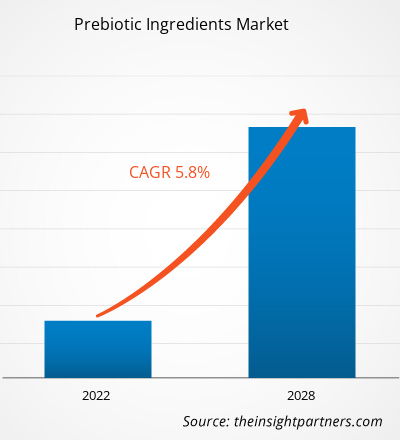[調査レポート]プレバイオティクス原料市場は、2021年の17億5,840万米ドルから2028年には26億772万米ドルに拡大し、2022年から2028年にかけて5.8%のCAGRで成長すると予想されています。
プレバイオティクスは、細菌や真菌などの有益な微生物の成長または活動を誘発する食品中の化合物です。有益な細菌が結腸内でプレバイオティクスを使用する主な作用機序は発酵です。スポーツ愛好家やアスリートの間でスタミナと持久力を高めるための食物繊維が豊富な栄養補助食品の人気が高まり、プレバイオティクス原料の需要がさらに高まっているため、プレバイオティクスは予防医療で重要な役割を果たしています。このように、予防医療への意識の高まりが、プレバイオティクス成分市場の成長を後押ししています。
2021年には、アジア太平洋地域がプレバイオティクス成分市場で最大のシェアを占めましたが、中東・アフリカなどの他の発展途上地域も予測期間中に大幅な成長が見込まれています。市場の成長は、消化器系疾患の増加に加え、腸内環境や免疫疾患の増加に起因しています。アジア諸国では、腸内環境の改善を目指し、健康的で栄養価の高い食品や飲料の摂取に傾倒しています。そのため、健康的な食品の摂取傾向が、プレバイオティクス成分市場の成長を牽引していると考えられます。
要件に合わせてレポートをカスタマイズ
レポートの一部、国レベルの分析、Excelデータパックなどを含め、スタートアップ&大学向けに特別オファーや割引もご利用いただけます(無償)
プレバイオティクス原料市場: 戦略的洞察

-
このレポートの主要な市場動向を入手してください。この無料サンプルには、市場動向から見積もりや予測に至るまでのデータ分析が含まれます。
COVID-19パンデミックによるプレバイオティクス原料市場への影響
COVID-19パンデミックは、2020年初頭、多くの分野に前例のない課題をもたらしました。WHOおよび各国保健省のガイドラインに基づき、各国政府が実施したロックダウン、国境規制、渡航禁止、製造中止、その他の安全対策により、製造業務は停滞しました。しかし、消費者が健康維持と免疫力強化のために、自然で安全な代替品を求める傾向が強まったため、COVID-19の流行は市場にプラスの影響を与えました。COVID-19パンデミック発生後数ヶ月間は、栄養補助食品の需要が劇的に増加しました。さらに、政府の命令により人々が家にいるため、健康とフィットネスに注目し、COVID-19パンデミック中にプレバイオティクスの需要を刺激しました。
市場洞察
食品および飲料セクターにおけるプレバイオティクス成分の需要増加
プレバイオティクスは、栄養バー、乳製品、健康ドリンク、ミネラルサプリメント、朝食用シリアル、ベーカリー製品、菓子類、グリーンフード、乳児用調製粉乳に使用されているため、食品および飲料業界で人気が高まっています。2018年11月、ケロッグ社は、腸内環境を整える消化器系製品のラインナップの一部として、プレバイオティクスとプロバイオティクスを含む新しいシリアルをHI! Happy Insideというブランド名で発売しました。さらに、イヌリンは脂肪や砂糖の優れた健康的な代替品として、食品加工に広く利用されています。米国、インド、中国などの主要な牛乳生産国では、プレバイオティクスを利用して最終製品に望ましい食感を与え、無糖乳製品を製造しています。さらに、乳児用調合乳やベビーフードには、ガラクトオリゴ糖、フラクトオリゴ糖、ポリデキストロースなど、さまざまなプレバイオティクス成分が含まれています。これらは、プレバイオティクス成分市場の成長を牽引する要因です。
タイプ別インサイト
プレバイオティクス成分市場は、タイプ別にイヌリン、フラクトオリゴ糖(FOS)、ガラクトオリゴ糖(GOS)、マンナンオリゴ糖(MOS)、その他に分類されています。予測期間中、イヌリンセグメントが最大のシェアを占めると予測されています。メーカーは、加工食品や飲料、栄養補助食品、動物飼料において、砂糖、脂肪、小麦粉の代替品としてイヌリンを使用しています。米国では2018年に食品医薬品局が製造食品の栄養価を高めるための食物繊維成分としてイヌリンを承認しました。さらに、天然物への需要の高まりから、プレバイオティクス イヌリンの需要が世界中で高まっています。イヌリン分野の成長は、様々な業界での用途の増加によって推進されており、プレバイオティクス成分市場の成長を後押ししています。
形態に基づく洞察
形態に基づいて、プレバイオティクス成分市場は粉末と液体に分類されます。粉末セグメントは、予測期間中に市場でより高いCAGRを記録すると予測されています。粉末の形状により、流通が容易になり、プレバイオティクス消費の利用が容易になりました。家畜生産にプレバイオティクス粉末を使用する利点は、粉末プレバイオティクスは家畜の生涯のどの段階でも消費できるため、人気が高まっています。また、肉、卵、牛乳の生産性の向上により、粉末プレバイオティクスの需要が高まっています。
用途ベースの洞察
用途に基づいて、プレバイオティクス成分市場は、機能性食品および飲料、栄養補助食品、動物飼料、その他に分類されています。栄養補助食品セグメントは、予測期間中に市場で最も高いCAGRを記録すると予測されています。予防薬の需要の高まり、高齢者の消化器疾患の増加、バランスの取れた食事の欠如により、栄養補助食品業界の製品需要が増加する可能性があります。不健康な食事の採用の増加により、消費者はプレバイオティクスベースの食品サプリメントを好む傾向が高まっています。
プレバイオティクス成分市場で活動している主要企業は、BENEO GmbH、COSUCRA、DuPont Nutrition & Biosciences、Clasado Ltd.、Nexira、Ingredion Incorporated、SOLACTIS、Cargill, Incorporatedです。 Sensus、Roquette Freresなどです。これらの企業は、新たな消費者トレンドに対応し、規制の枠組みを遵守するために、健康リスクを低減した製品の開発に取り組んでいます。市場シェア拡大のため、合併・買収、事業拡大、提携にも積極的に取り組んでいます。
プレバイオティクス原料市場の地域別分析
予測期間を通じてプレバイオティクス原料市場に影響を与える地域的な傾向と要因は、The Insight Partnersのアナリストによって詳細に説明されています。このセクションでは、北米、ヨーロッパ、アジア太平洋、中東・アフリカ、中南米におけるプレバイオティクス原料市場のセグメントと地域についても説明します。
プレバイオティクス成分市場レポートの範囲
| レポート属性 | 詳細 |
|---|---|
| の市場規模 2021 | US$ 1.76 Billion |
| 市場規模別 2028 | US$ 2.61 Billion |
| 世界的なCAGR (2021 - 2028) | 5.8% |
| 過去データ | 2019-2020 |
| 予測期間 | 2022-2028 |
| 対象セグメント |
By 種類
|
| 対象地域と国 |
北米
|
| 市場リーダーと主要企業の概要 |
|
プレバイオティクス原料市場のプレーヤー密度:ビジネスダイナミクスへの影響を理解する
プレバイオティクス成分市場は、消費者の嗜好の変化、技術の進歩、製品効果への認知度の高まりといった要因によるエンドユーザーの需要増加に牽引され、急速に成長しています。需要の増加に伴い、企業は製品ラインナップの拡充、消費者ニーズへの対応のためのイノベーション、そして新たなトレンドの活用を進めており、これが市場の成長をさらに加速させています。

- 入手 プレバイオティクス原料市場 主要プレーヤーの概要
レポートの注目点
- プレバイオティクス原料市場における進歩的な業界動向。企業が効果的な長期戦略を策定するのに役立ちます
- 先進国および発展途上国市場での成長を確保するために採用されたビジネス成長戦略
- 2022年から2028年までのプレバイオティクス原料市場の定量分析
- プロバイオティクスの世界的需要の推定
- 業界で事業を展開しているバイヤーとサプライヤーの有効性を示すポーターのファイブフォース分析
- 競争の激しい市場シナリオを理解するための最近の動向
- 市場動向と展望、そしてプレバイオティクス原料市場の成長を左右する要因
- 商業的関心を支え、市場の成長につながる市場戦略を強調することで、意思決定プロセスを支援
- さまざまなノードにおけるプレバイオティクス原料市場の規模
- 市場とプロバイオティクス業界のダイナミクス
- 有望な成長機会のあるさまざまな地域における成長の規模
- 過去2年間の分析、基準年、CAGRによる予測(7年間)
- PEST分析とSWOT分析
- 市場規模価値/数量 - 世界、地域、国
- 業界と競争環境
- Excel データセット
最新レポート
関連レポート
お客様の声
購入理由
- 情報に基づいた意思決定
- 市場動向の理解
- 競合分析
- 顧客インサイト
- 市場予測
- リスク軽減
- 戦略計画
- 投資の正当性
- 新興市場の特定
- マーケティング戦略の強化
- 業務効率の向上
- 規制動向への対応






















 無料サンプルを入手 - プレバイオティクス原料市場
無料サンプルを入手 - プレバイオティクス原料市場